Drug Addiction in Australia: Analysis of National Drug Strategies
VerifiedAdded on 2023/04/03
|14
|3106
|108
Essay
AI Summary
This essay provides a comprehensive analysis of drug addiction in Australia, highlighting the prevalence of illicit and prescription drug abuse and its associated health issues. It examines the Australian approach to drug policy through its National Drug Strategies (NDS), focusing on harm minimization, demand and supply reduction, and priority areas. The essay discusses the challenges faced by the NDS, including debates over harm minimization concepts and implementation issues. It concludes with recommendations for improving the effectiveness of the NDS, such as enhancing education, strengthening partnerships, and increasing community involvement, advocating for a more balanced and evidence-based approach to addressing drug addiction in Australia. Desklib offers a wealth of resources for students, including past papers and solved assignments.
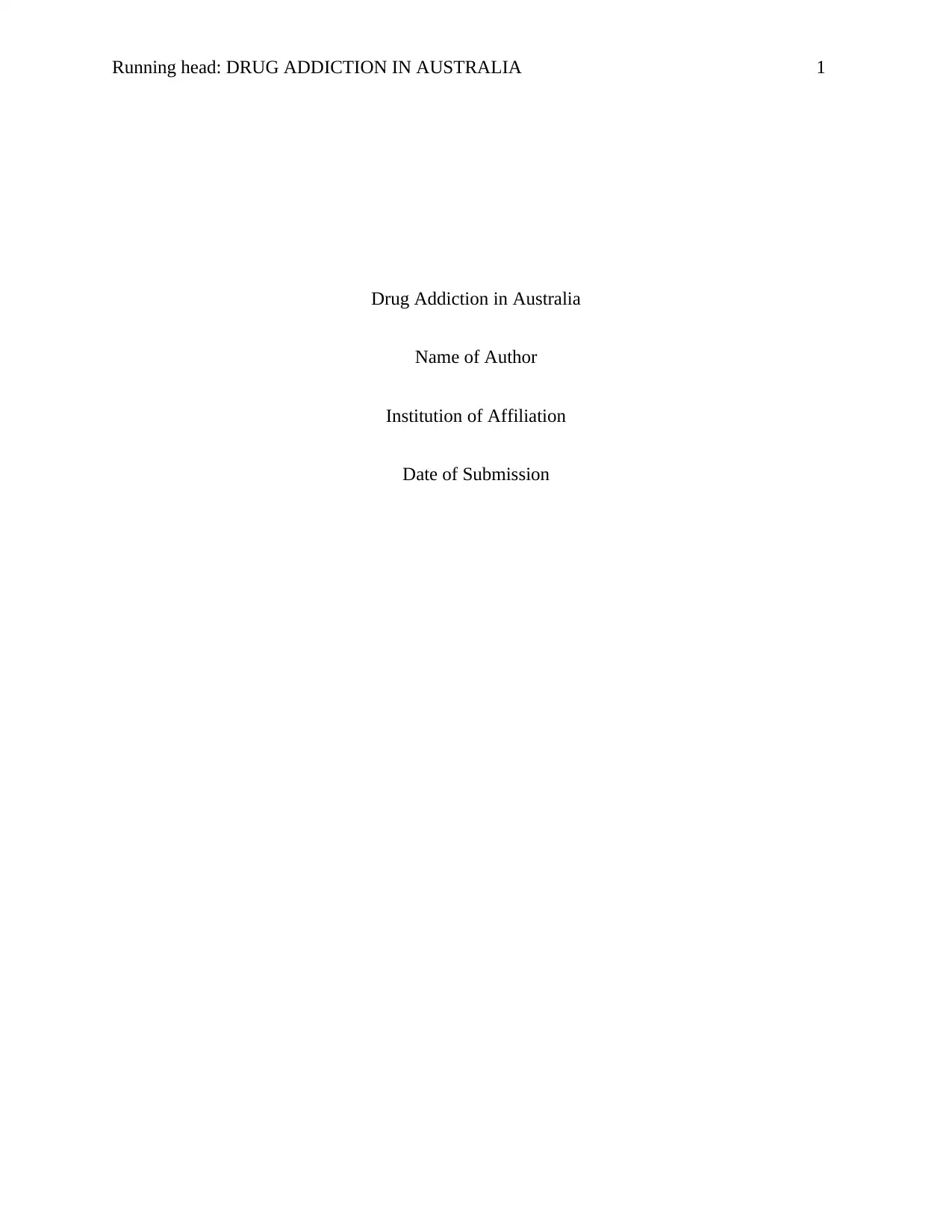
Running head: DRUG ADDICTION IN AUSTRALIA 1
Drug Addiction in Australia
Name of Author
Institution of Affiliation
Date of Submission
Drug Addiction in Australia
Name of Author
Institution of Affiliation
Date of Submission
Paraphrase This Document
Need a fresh take? Get an instant paraphrase of this document with our AI Paraphraser
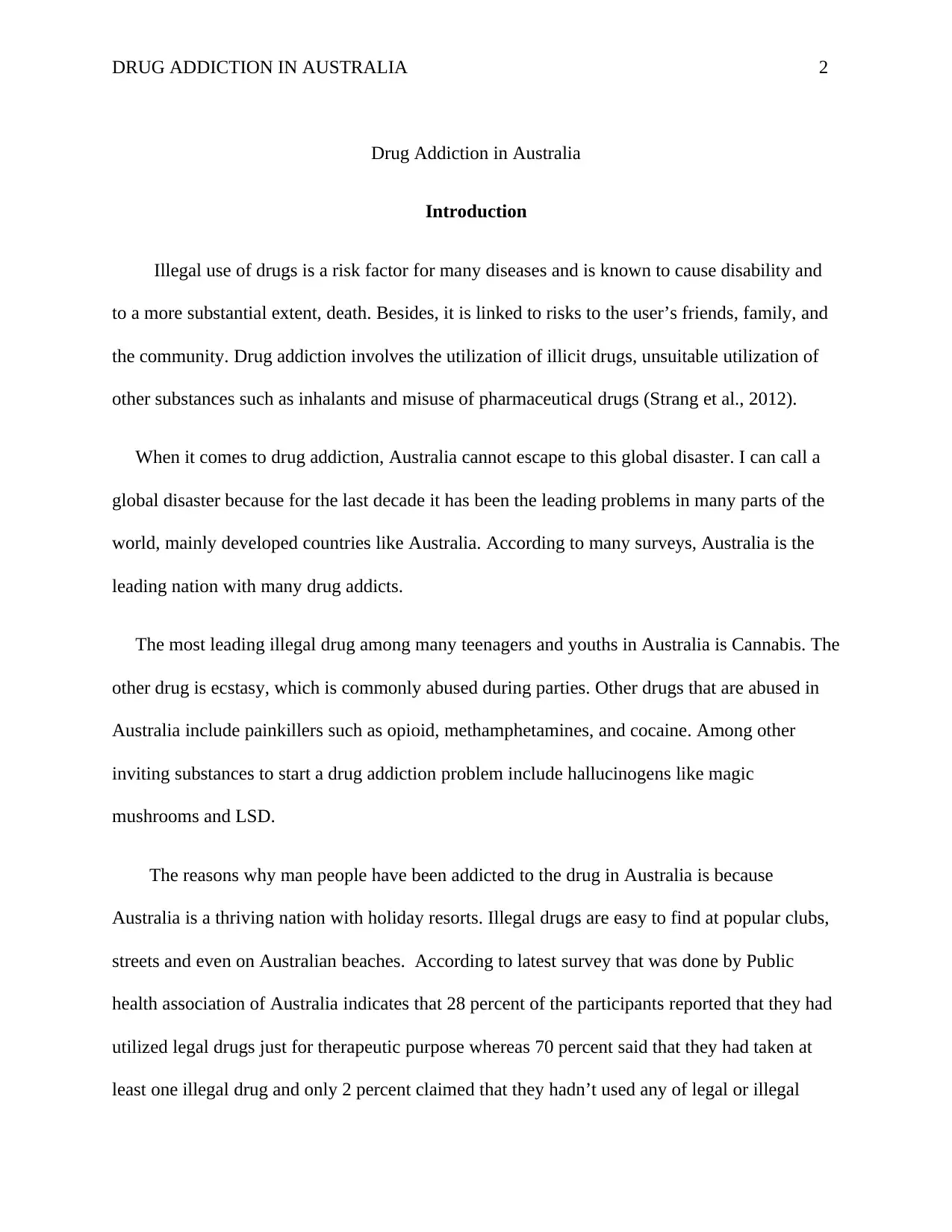
DRUG ADDICTION IN AUSTRALIA 2
Drug Addiction in Australia
Introduction
Illegal use of drugs is a risk factor for many diseases and is known to cause disability and
to a more substantial extent, death. Besides, it is linked to risks to the user’s friends, family, and
the community. Drug addiction involves the utilization of illicit drugs, unsuitable utilization of
other substances such as inhalants and misuse of pharmaceutical drugs (Strang et al., 2012).
When it comes to drug addiction, Australia cannot escape to this global disaster. I can call a
global disaster because for the last decade it has been the leading problems in many parts of the
world, mainly developed countries like Australia. According to many surveys, Australia is the
leading nation with many drug addicts.
The most leading illegal drug among many teenagers and youths in Australia is Cannabis. The
other drug is ecstasy, which is commonly abused during parties. Other drugs that are abused in
Australia include painkillers such as opioid, methamphetamines, and cocaine. Among other
inviting substances to start a drug addiction problem include hallucinogens like magic
mushrooms and LSD.
The reasons why man people have been addicted to the drug in Australia is because
Australia is a thriving nation with holiday resorts. Illegal drugs are easy to find at popular clubs,
streets and even on Australian beaches. According to latest survey that was done by Public
health association of Australia indicates that 28 percent of the participants reported that they had
utilized legal drugs just for therapeutic purpose whereas 70 percent said that they had taken at
least one illegal drug and only 2 percent claimed that they hadn’t used any of legal or illegal
Drug Addiction in Australia
Introduction
Illegal use of drugs is a risk factor for many diseases and is known to cause disability and
to a more substantial extent, death. Besides, it is linked to risks to the user’s friends, family, and
the community. Drug addiction involves the utilization of illicit drugs, unsuitable utilization of
other substances such as inhalants and misuse of pharmaceutical drugs (Strang et al., 2012).
When it comes to drug addiction, Australia cannot escape to this global disaster. I can call a
global disaster because for the last decade it has been the leading problems in many parts of the
world, mainly developed countries like Australia. According to many surveys, Australia is the
leading nation with many drug addicts.
The most leading illegal drug among many teenagers and youths in Australia is Cannabis. The
other drug is ecstasy, which is commonly abused during parties. Other drugs that are abused in
Australia include painkillers such as opioid, methamphetamines, and cocaine. Among other
inviting substances to start a drug addiction problem include hallucinogens like magic
mushrooms and LSD.
The reasons why man people have been addicted to the drug in Australia is because
Australia is a thriving nation with holiday resorts. Illegal drugs are easy to find at popular clubs,
streets and even on Australian beaches. According to latest survey that was done by Public
health association of Australia indicates that 28 percent of the participants reported that they had
utilized legal drugs just for therapeutic purpose whereas 70 percent said that they had taken at
least one illegal drug and only 2 percent claimed that they hadn’t used any of legal or illegal
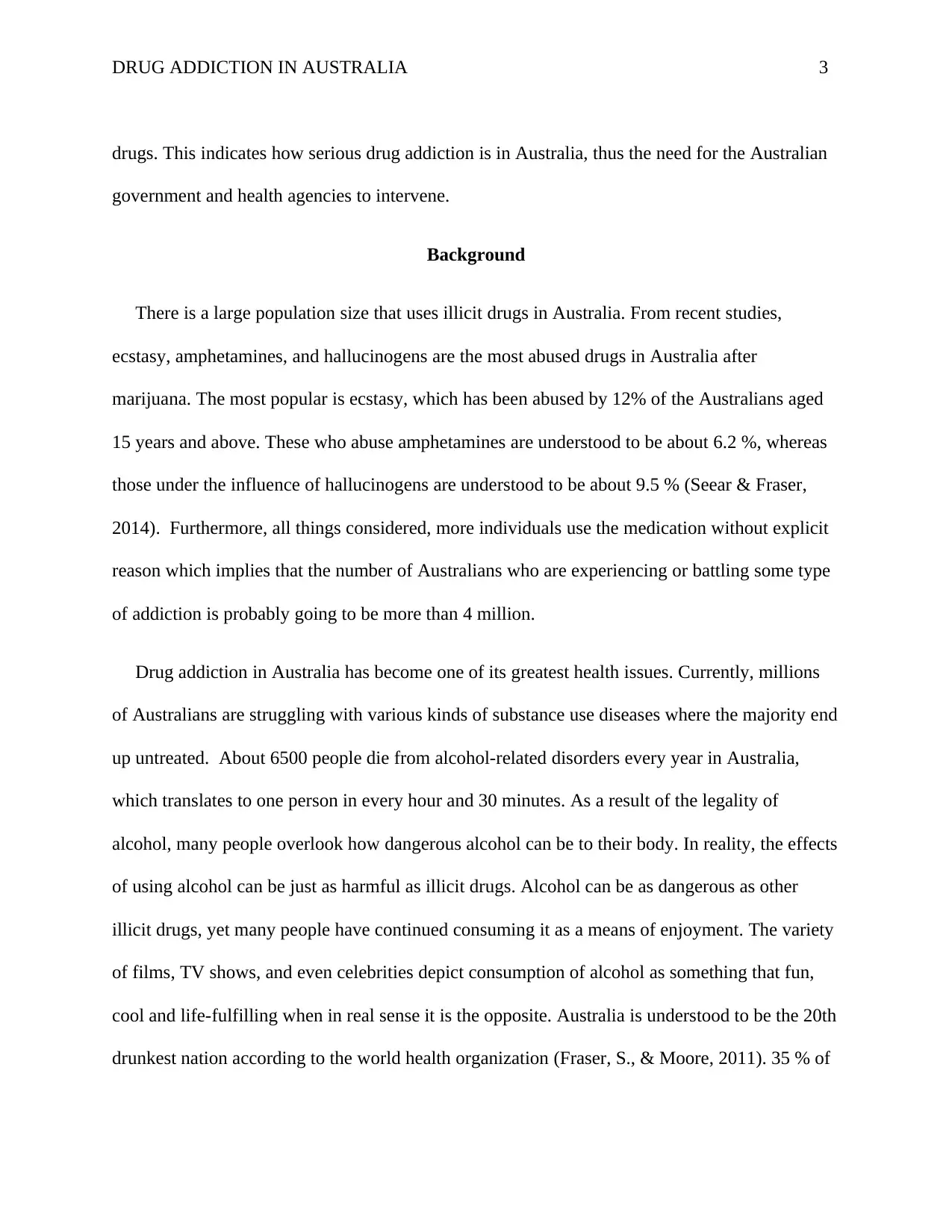
DRUG ADDICTION IN AUSTRALIA 3
drugs. This indicates how serious drug addiction is in Australia, thus the need for the Australian
government and health agencies to intervene.
Background
There is a large population size that uses illicit drugs in Australia. From recent studies,
ecstasy, amphetamines, and hallucinogens are the most abused drugs in Australia after
marijuana. The most popular is ecstasy, which has been abused by 12% of the Australians aged
15 years and above. These who abuse amphetamines are understood to be about 6.2 %, whereas
those under the influence of hallucinogens are understood to be about 9.5 % (Seear & Fraser,
2014). Furthermore, all things considered, more individuals use the medication without explicit
reason which implies that the number of Australians who are experiencing or battling some type
of addiction is probably going to be more than 4 million.
Drug addiction in Australia has become one of its greatest health issues. Currently, millions
of Australians are struggling with various kinds of substance use diseases where the majority end
up untreated. About 6500 people die from alcohol-related disorders every year in Australia,
which translates to one person in every hour and 30 minutes. As a result of the legality of
alcohol, many people overlook how dangerous alcohol can be to their body. In reality, the effects
of using alcohol can be just as harmful as illicit drugs. Alcohol can be as dangerous as other
illicit drugs, yet many people have continued consuming it as a means of enjoyment. The variety
of films, TV shows, and even celebrities depict consumption of alcohol as something that fun,
cool and life-fulfilling when in real sense it is the opposite. Australia is understood to be the 20th
drunkest nation according to the world health organization (Fraser, S., & Moore, 2011). 35 % of
drugs. This indicates how serious drug addiction is in Australia, thus the need for the Australian
government and health agencies to intervene.
Background
There is a large population size that uses illicit drugs in Australia. From recent studies,
ecstasy, amphetamines, and hallucinogens are the most abused drugs in Australia after
marijuana. The most popular is ecstasy, which has been abused by 12% of the Australians aged
15 years and above. These who abuse amphetamines are understood to be about 6.2 %, whereas
those under the influence of hallucinogens are understood to be about 9.5 % (Seear & Fraser,
2014). Furthermore, all things considered, more individuals use the medication without explicit
reason which implies that the number of Australians who are experiencing or battling some type
of addiction is probably going to be more than 4 million.
Drug addiction in Australia has become one of its greatest health issues. Currently, millions
of Australians are struggling with various kinds of substance use diseases where the majority end
up untreated. About 6500 people die from alcohol-related disorders every year in Australia,
which translates to one person in every hour and 30 minutes. As a result of the legality of
alcohol, many people overlook how dangerous alcohol can be to their body. In reality, the effects
of using alcohol can be just as harmful as illicit drugs. Alcohol can be as dangerous as other
illicit drugs, yet many people have continued consuming it as a means of enjoyment. The variety
of films, TV shows, and even celebrities depict consumption of alcohol as something that fun,
cool and life-fulfilling when in real sense it is the opposite. Australia is understood to be the 20th
drunkest nation according to the world health organization (Fraser, S., & Moore, 2011). 35 % of
⊘ This is a preview!⊘
Do you want full access?
Subscribe today to unlock all pages.

Trusted by 1+ million students worldwide
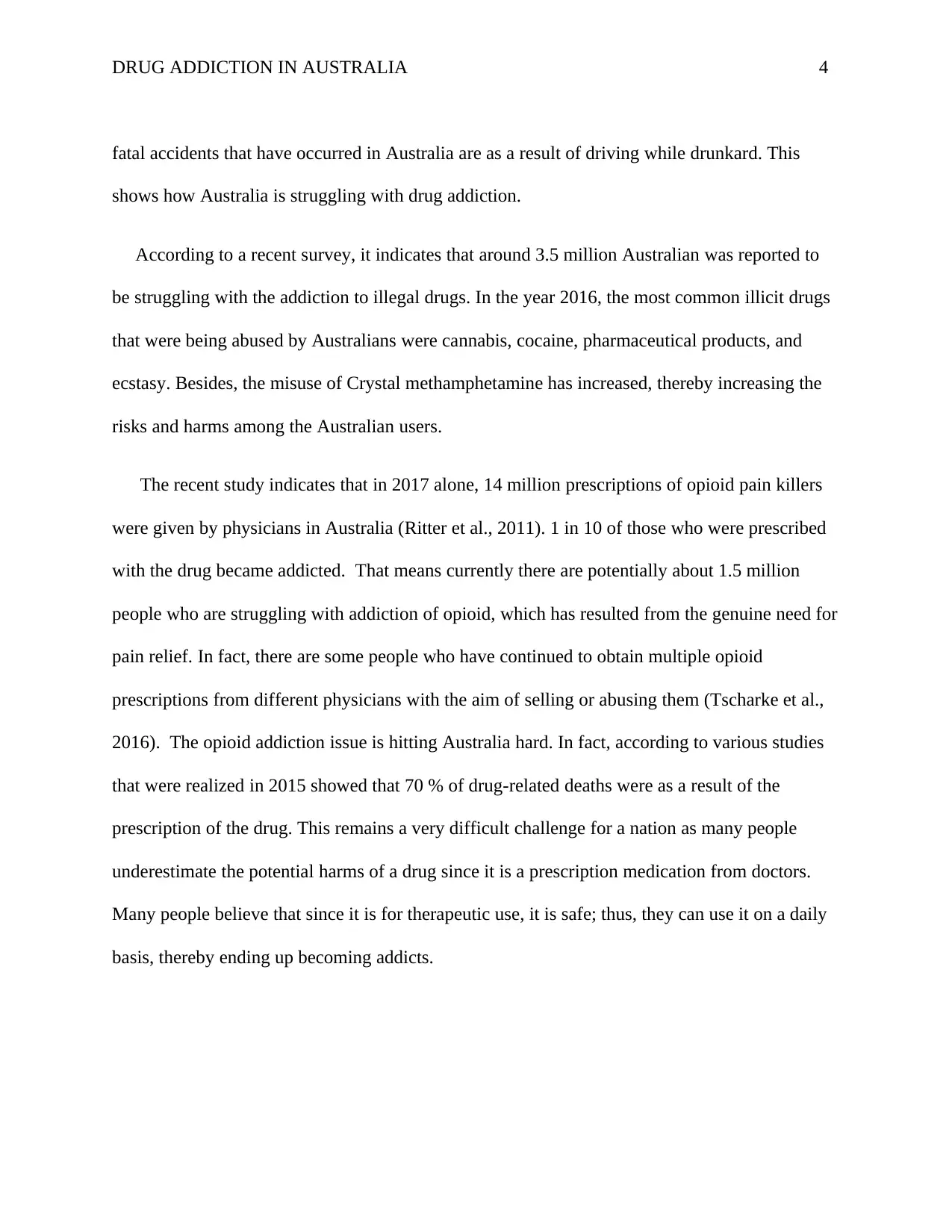
DRUG ADDICTION IN AUSTRALIA 4
fatal accidents that have occurred in Australia are as a result of driving while drunkard. This
shows how Australia is struggling with drug addiction.
According to a recent survey, it indicates that around 3.5 million Australian was reported to
be struggling with the addiction to illegal drugs. In the year 2016, the most common illicit drugs
that were being abused by Australians were cannabis, cocaine, pharmaceutical products, and
ecstasy. Besides, the misuse of Crystal methamphetamine has increased, thereby increasing the
risks and harms among the Australian users.
The recent study indicates that in 2017 alone, 14 million prescriptions of opioid pain killers
were given by physicians in Australia (Ritter et al., 2011). 1 in 10 of those who were prescribed
with the drug became addicted. That means currently there are potentially about 1.5 million
people who are struggling with addiction of opioid, which has resulted from the genuine need for
pain relief. In fact, there are some people who have continued to obtain multiple opioid
prescriptions from different physicians with the aim of selling or abusing them (Tscharke et al.,
2016). The opioid addiction issue is hitting Australia hard. In fact, according to various studies
that were realized in 2015 showed that 70 % of drug-related deaths were as a result of the
prescription of the drug. This remains a very difficult challenge for a nation as many people
underestimate the potential harms of a drug since it is a prescription medication from doctors.
Many people believe that since it is for therapeutic use, it is safe; thus, they can use it on a daily
basis, thereby ending up becoming addicts.
fatal accidents that have occurred in Australia are as a result of driving while drunkard. This
shows how Australia is struggling with drug addiction.
According to a recent survey, it indicates that around 3.5 million Australian was reported to
be struggling with the addiction to illegal drugs. In the year 2016, the most common illicit drugs
that were being abused by Australians were cannabis, cocaine, pharmaceutical products, and
ecstasy. Besides, the misuse of Crystal methamphetamine has increased, thereby increasing the
risks and harms among the Australian users.
The recent study indicates that in 2017 alone, 14 million prescriptions of opioid pain killers
were given by physicians in Australia (Ritter et al., 2011). 1 in 10 of those who were prescribed
with the drug became addicted. That means currently there are potentially about 1.5 million
people who are struggling with addiction of opioid, which has resulted from the genuine need for
pain relief. In fact, there are some people who have continued to obtain multiple opioid
prescriptions from different physicians with the aim of selling or abusing them (Tscharke et al.,
2016). The opioid addiction issue is hitting Australia hard. In fact, according to various studies
that were realized in 2015 showed that 70 % of drug-related deaths were as a result of the
prescription of the drug. This remains a very difficult challenge for a nation as many people
underestimate the potential harms of a drug since it is a prescription medication from doctors.
Many people believe that since it is for therapeutic use, it is safe; thus, they can use it on a daily
basis, thereby ending up becoming addicts.
Paraphrase This Document
Need a fresh take? Get an instant paraphrase of this document with our AI Paraphraser
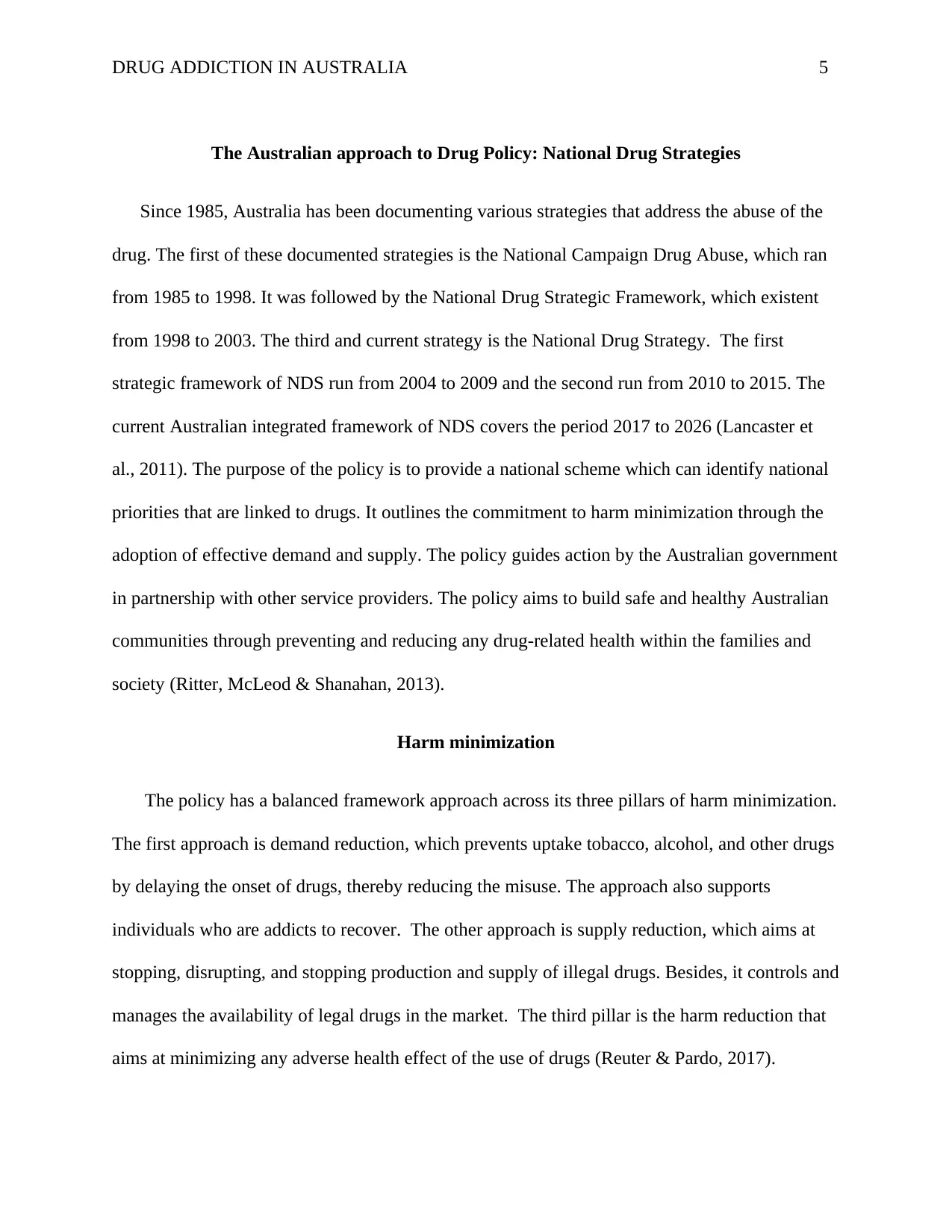
DRUG ADDICTION IN AUSTRALIA 5
The Australian approach to Drug Policy: National Drug Strategies
Since 1985, Australia has been documenting various strategies that address the abuse of the
drug. The first of these documented strategies is the National Campaign Drug Abuse, which ran
from 1985 to 1998. It was followed by the National Drug Strategic Framework, which existent
from 1998 to 2003. The third and current strategy is the National Drug Strategy. The first
strategic framework of NDS run from 2004 to 2009 and the second run from 2010 to 2015. The
current Australian integrated framework of NDS covers the period 2017 to 2026 (Lancaster et
al., 2011). The purpose of the policy is to provide a national scheme which can identify national
priorities that are linked to drugs. It outlines the commitment to harm minimization through the
adoption of effective demand and supply. The policy guides action by the Australian government
in partnership with other service providers. The policy aims to build safe and healthy Australian
communities through preventing and reducing any drug-related health within the families and
society (Ritter, McLeod & Shanahan, 2013).
Harm minimization
The policy has a balanced framework approach across its three pillars of harm minimization.
The first approach is demand reduction, which prevents uptake tobacco, alcohol, and other drugs
by delaying the onset of drugs, thereby reducing the misuse. The approach also supports
individuals who are addicts to recover. The other approach is supply reduction, which aims at
stopping, disrupting, and stopping production and supply of illegal drugs. Besides, it controls and
manages the availability of legal drugs in the market. The third pillar is the harm reduction that
aims at minimizing any adverse health effect of the use of drugs (Reuter & Pardo, 2017).
The Australian approach to Drug Policy: National Drug Strategies
Since 1985, Australia has been documenting various strategies that address the abuse of the
drug. The first of these documented strategies is the National Campaign Drug Abuse, which ran
from 1985 to 1998. It was followed by the National Drug Strategic Framework, which existent
from 1998 to 2003. The third and current strategy is the National Drug Strategy. The first
strategic framework of NDS run from 2004 to 2009 and the second run from 2010 to 2015. The
current Australian integrated framework of NDS covers the period 2017 to 2026 (Lancaster et
al., 2011). The purpose of the policy is to provide a national scheme which can identify national
priorities that are linked to drugs. It outlines the commitment to harm minimization through the
adoption of effective demand and supply. The policy guides action by the Australian government
in partnership with other service providers. The policy aims to build safe and healthy Australian
communities through preventing and reducing any drug-related health within the families and
society (Ritter, McLeod & Shanahan, 2013).
Harm minimization
The policy has a balanced framework approach across its three pillars of harm minimization.
The first approach is demand reduction, which prevents uptake tobacco, alcohol, and other drugs
by delaying the onset of drugs, thereby reducing the misuse. The approach also supports
individuals who are addicts to recover. The other approach is supply reduction, which aims at
stopping, disrupting, and stopping production and supply of illegal drugs. Besides, it controls and
manages the availability of legal drugs in the market. The third pillar is the harm reduction that
aims at minimizing any adverse health effect of the use of drugs (Reuter & Pardo, 2017).
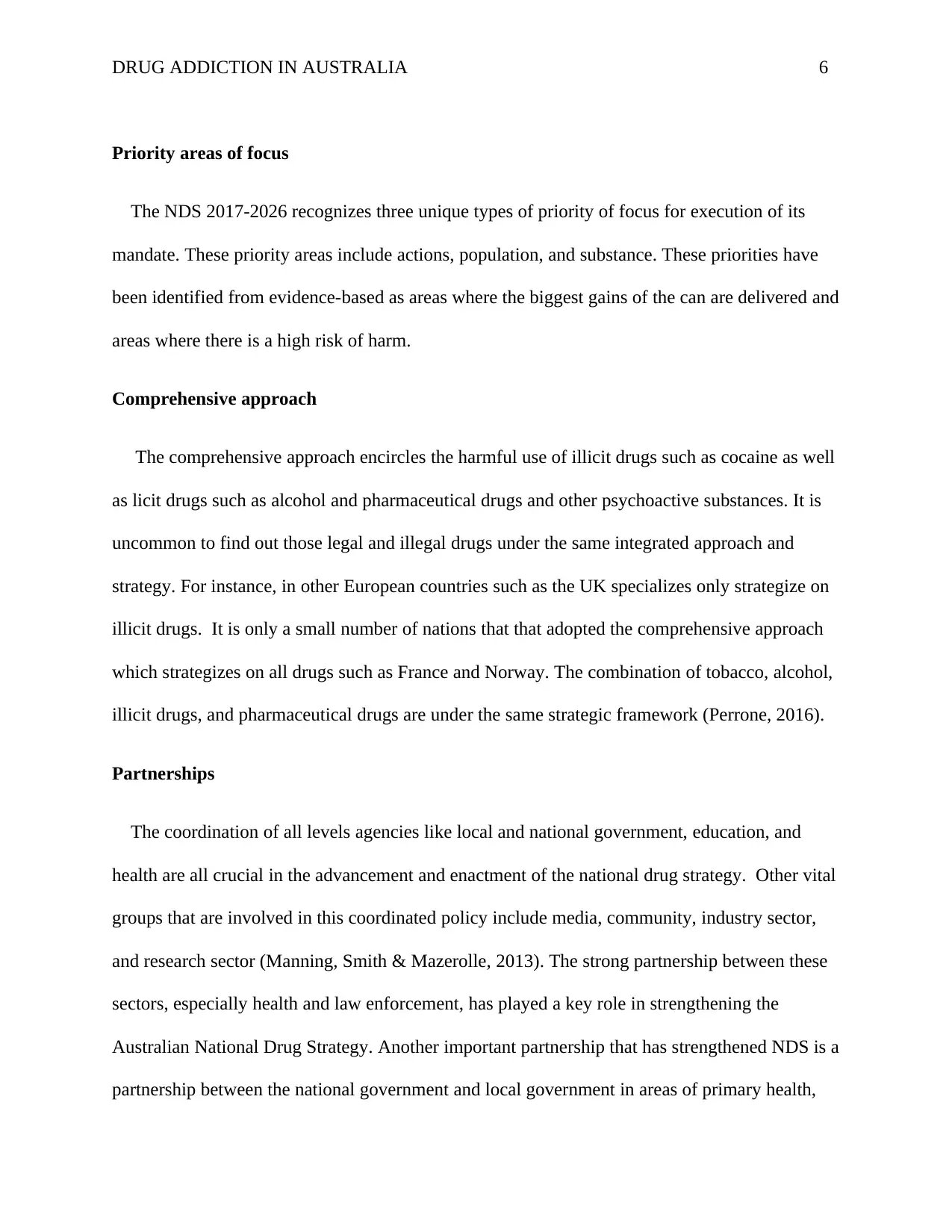
DRUG ADDICTION IN AUSTRALIA 6
Priority areas of focus
The NDS 2017-2026 recognizes three unique types of priority of focus for execution of its
mandate. These priority areas include actions, population, and substance. These priorities have
been identified from evidence-based as areas where the biggest gains of the can are delivered and
areas where there is a high risk of harm.
Comprehensive approach
The comprehensive approach encircles the harmful use of illicit drugs such as cocaine as well
as licit drugs such as alcohol and pharmaceutical drugs and other psychoactive substances. It is
uncommon to find out those legal and illegal drugs under the same integrated approach and
strategy. For instance, in other European countries such as the UK specializes only strategize on
illicit drugs. It is only a small number of nations that that adopted the comprehensive approach
which strategizes on all drugs such as France and Norway. The combination of tobacco, alcohol,
illicit drugs, and pharmaceutical drugs are under the same strategic framework (Perrone, 2016).
Partnerships
The coordination of all levels agencies like local and national government, education, and
health are all crucial in the advancement and enactment of the national drug strategy. Other vital
groups that are involved in this coordinated policy include media, community, industry sector,
and research sector (Manning, Smith & Mazerolle, 2013). The strong partnership between these
sectors, especially health and law enforcement, has played a key role in strengthening the
Australian National Drug Strategy. Another important partnership that has strengthened NDS is a
partnership between the national government and local government in areas of primary health,
Priority areas of focus
The NDS 2017-2026 recognizes three unique types of priority of focus for execution of its
mandate. These priority areas include actions, population, and substance. These priorities have
been identified from evidence-based as areas where the biggest gains of the can are delivered and
areas where there is a high risk of harm.
Comprehensive approach
The comprehensive approach encircles the harmful use of illicit drugs such as cocaine as well
as licit drugs such as alcohol and pharmaceutical drugs and other psychoactive substances. It is
uncommon to find out those legal and illegal drugs under the same integrated approach and
strategy. For instance, in other European countries such as the UK specializes only strategize on
illicit drugs. It is only a small number of nations that that adopted the comprehensive approach
which strategizes on all drugs such as France and Norway. The combination of tobacco, alcohol,
illicit drugs, and pharmaceutical drugs are under the same strategic framework (Perrone, 2016).
Partnerships
The coordination of all levels agencies like local and national government, education, and
health are all crucial in the advancement and enactment of the national drug strategy. Other vital
groups that are involved in this coordinated policy include media, community, industry sector,
and research sector (Manning, Smith & Mazerolle, 2013). The strong partnership between these
sectors, especially health and law enforcement, has played a key role in strengthening the
Australian National Drug Strategy. Another important partnership that has strengthened NDS is a
partnership between the national government and local government in areas of primary health,
⊘ This is a preview!⊘
Do you want full access?
Subscribe today to unlock all pages.

Trusted by 1+ million students worldwide
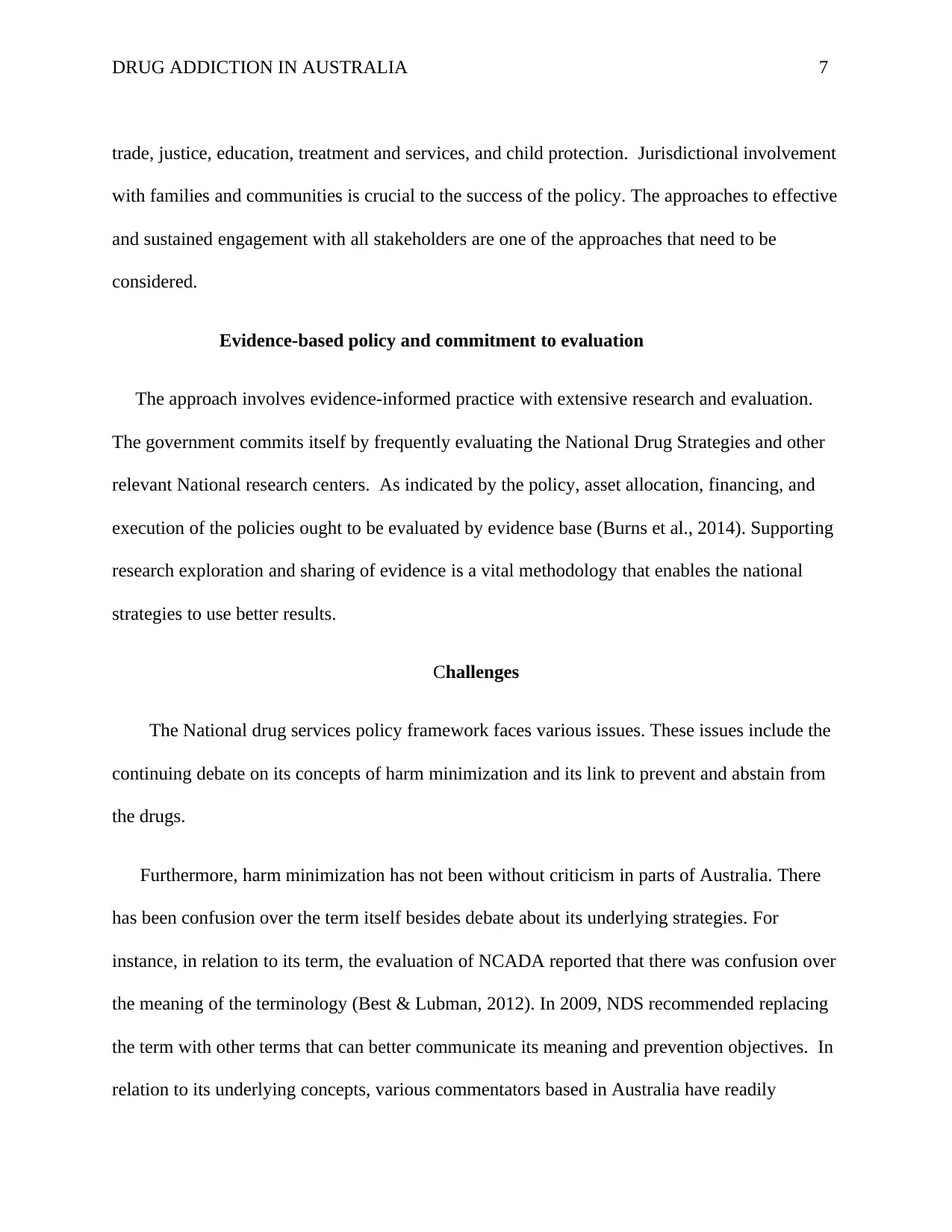
DRUG ADDICTION IN AUSTRALIA 7
trade, justice, education, treatment and services, and child protection. Jurisdictional involvement
with families and communities is crucial to the success of the policy. The approaches to effective
and sustained engagement with all stakeholders are one of the approaches that need to be
considered.
Evidence-based policy and commitment to evaluation
The approach involves evidence-informed practice with extensive research and evaluation.
The government commits itself by frequently evaluating the National Drug Strategies and other
relevant National research centers. As indicated by the policy, asset allocation, financing, and
execution of the policies ought to be evaluated by evidence base (Burns et al., 2014). Supporting
research exploration and sharing of evidence is a vital methodology that enables the national
strategies to use better results.
Challenges
The National drug services policy framework faces various issues. These issues include the
continuing debate on its concepts of harm minimization and its link to prevent and abstain from
the drugs.
Furthermore, harm minimization has not been without criticism in parts of Australia. There
has been confusion over the term itself besides debate about its underlying strategies. For
instance, in relation to its term, the evaluation of NCADA reported that there was confusion over
the meaning of the terminology (Best & Lubman, 2012). In 2009, NDS recommended replacing
the term with other terms that can better communicate its meaning and prevention objectives. In
relation to its underlying concepts, various commentators based in Australia have readily
trade, justice, education, treatment and services, and child protection. Jurisdictional involvement
with families and communities is crucial to the success of the policy. The approaches to effective
and sustained engagement with all stakeholders are one of the approaches that need to be
considered.
Evidence-based policy and commitment to evaluation
The approach involves evidence-informed practice with extensive research and evaluation.
The government commits itself by frequently evaluating the National Drug Strategies and other
relevant National research centers. As indicated by the policy, asset allocation, financing, and
execution of the policies ought to be evaluated by evidence base (Burns et al., 2014). Supporting
research exploration and sharing of evidence is a vital methodology that enables the national
strategies to use better results.
Challenges
The National drug services policy framework faces various issues. These issues include the
continuing debate on its concepts of harm minimization and its link to prevent and abstain from
the drugs.
Furthermore, harm minimization has not been without criticism in parts of Australia. There
has been confusion over the term itself besides debate about its underlying strategies. For
instance, in relation to its term, the evaluation of NCADA reported that there was confusion over
the meaning of the terminology (Best & Lubman, 2012). In 2009, NDS recommended replacing
the term with other terms that can better communicate its meaning and prevention objectives. In
relation to its underlying concepts, various commentators based in Australia have readily
Paraphrase This Document
Need a fresh take? Get an instant paraphrase of this document with our AI Paraphraser
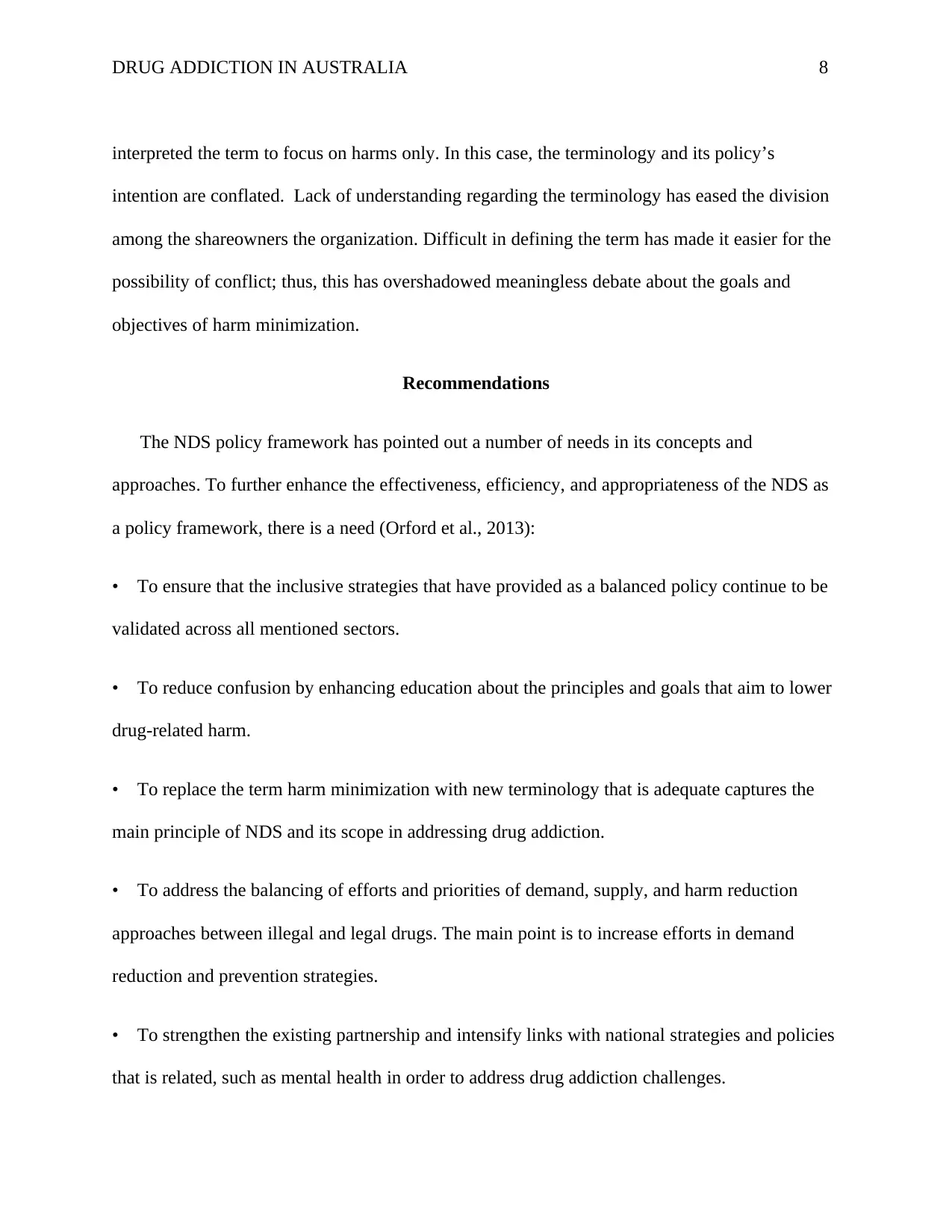
DRUG ADDICTION IN AUSTRALIA 8
interpreted the term to focus on harms only. In this case, the terminology and its policy’s
intention are conflated. Lack of understanding regarding the terminology has eased the division
among the shareowners the organization. Difficult in defining the term has made it easier for the
possibility of conflict; thus, this has overshadowed meaningless debate about the goals and
objectives of harm minimization.
Recommendations
The NDS policy framework has pointed out a number of needs in its concepts and
approaches. To further enhance the effectiveness, efficiency, and appropriateness of the NDS as
a policy framework, there is a need (Orford et al., 2013):
• To ensure that the inclusive strategies that have provided as a balanced policy continue to be
validated across all mentioned sectors.
• To reduce confusion by enhancing education about the principles and goals that aim to lower
drug-related harm.
• To replace the term harm minimization with new terminology that is adequate captures the
main principle of NDS and its scope in addressing drug addiction.
• To address the balancing of efforts and priorities of demand, supply, and harm reduction
approaches between illegal and legal drugs. The main point is to increase efforts in demand
reduction and prevention strategies.
• To strengthen the existing partnership and intensify links with national strategies and policies
that is related, such as mental health in order to address drug addiction challenges.
interpreted the term to focus on harms only. In this case, the terminology and its policy’s
intention are conflated. Lack of understanding regarding the terminology has eased the division
among the shareowners the organization. Difficult in defining the term has made it easier for the
possibility of conflict; thus, this has overshadowed meaningless debate about the goals and
objectives of harm minimization.
Recommendations
The NDS policy framework has pointed out a number of needs in its concepts and
approaches. To further enhance the effectiveness, efficiency, and appropriateness of the NDS as
a policy framework, there is a need (Orford et al., 2013):
• To ensure that the inclusive strategies that have provided as a balanced policy continue to be
validated across all mentioned sectors.
• To reduce confusion by enhancing education about the principles and goals that aim to lower
drug-related harm.
• To replace the term harm minimization with new terminology that is adequate captures the
main principle of NDS and its scope in addressing drug addiction.
• To address the balancing of efforts and priorities of demand, supply, and harm reduction
approaches between illegal and legal drugs. The main point is to increase efforts in demand
reduction and prevention strategies.
• To strengthen the existing partnership and intensify links with national strategies and policies
that is related, such as mental health in order to address drug addiction challenges.
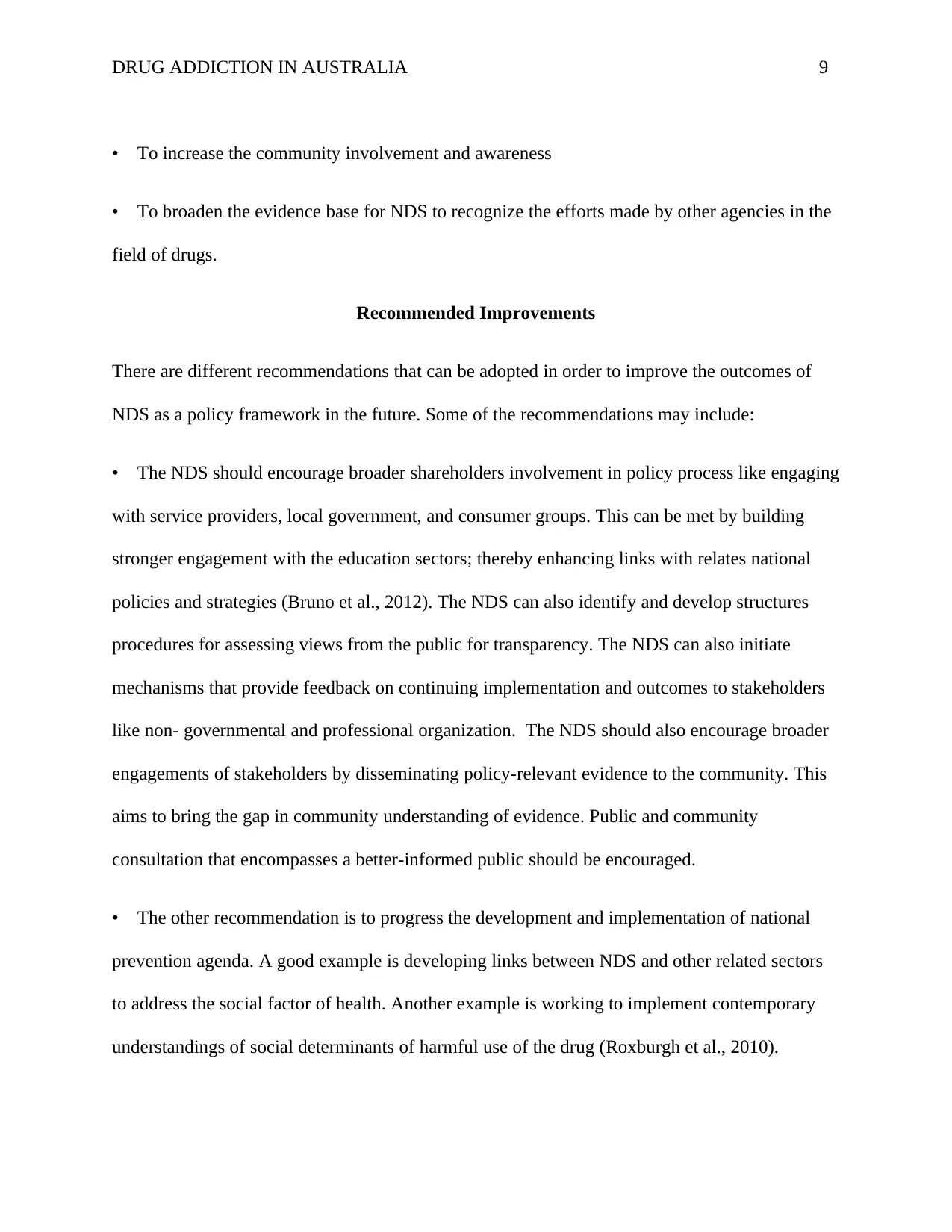
DRUG ADDICTION IN AUSTRALIA 9
• To increase the community involvement and awareness
• To broaden the evidence base for NDS to recognize the efforts made by other agencies in the
field of drugs.
Recommended Improvements
There are different recommendations that can be adopted in order to improve the outcomes of
NDS as a policy framework in the future. Some of the recommendations may include:
• The NDS should encourage broader shareholders involvement in policy process like engaging
with service providers, local government, and consumer groups. This can be met by building
stronger engagement with the education sectors; thereby enhancing links with relates national
policies and strategies (Bruno et al., 2012). The NDS can also identify and develop structures
procedures for assessing views from the public for transparency. The NDS can also initiate
mechanisms that provide feedback on continuing implementation and outcomes to stakeholders
like non- governmental and professional organization. The NDS should also encourage broader
engagements of stakeholders by disseminating policy-relevant evidence to the community. This
aims to bring the gap in community understanding of evidence. Public and community
consultation that encompasses a better-informed public should be encouraged.
• The other recommendation is to progress the development and implementation of national
prevention agenda. A good example is developing links between NDS and other related sectors
to address the social factor of health. Another example is working to implement contemporary
understandings of social determinants of harmful use of the drug (Roxburgh et al., 2010).
• To increase the community involvement and awareness
• To broaden the evidence base for NDS to recognize the efforts made by other agencies in the
field of drugs.
Recommended Improvements
There are different recommendations that can be adopted in order to improve the outcomes of
NDS as a policy framework in the future. Some of the recommendations may include:
• The NDS should encourage broader shareholders involvement in policy process like engaging
with service providers, local government, and consumer groups. This can be met by building
stronger engagement with the education sectors; thereby enhancing links with relates national
policies and strategies (Bruno et al., 2012). The NDS can also identify and develop structures
procedures for assessing views from the public for transparency. The NDS can also initiate
mechanisms that provide feedback on continuing implementation and outcomes to stakeholders
like non- governmental and professional organization. The NDS should also encourage broader
engagements of stakeholders by disseminating policy-relevant evidence to the community. This
aims to bring the gap in community understanding of evidence. Public and community
consultation that encompasses a better-informed public should be encouraged.
• The other recommendation is to progress the development and implementation of national
prevention agenda. A good example is developing links between NDS and other related sectors
to address the social factor of health. Another example is working to implement contemporary
understandings of social determinants of harmful use of the drug (Roxburgh et al., 2010).
⊘ This is a preview!⊘
Do you want full access?
Subscribe today to unlock all pages.

Trusted by 1+ million students worldwide
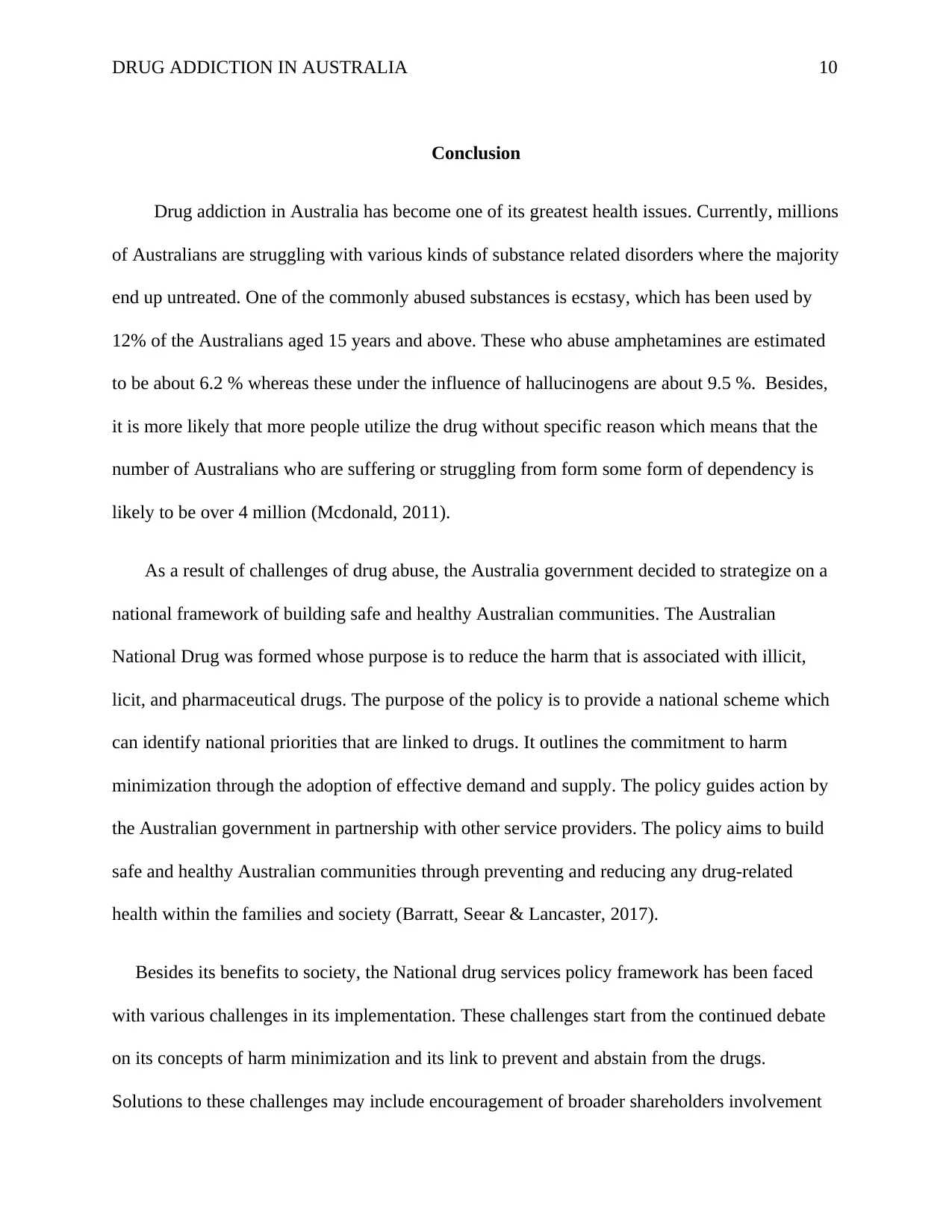
DRUG ADDICTION IN AUSTRALIA 10
Conclusion
Drug addiction in Australia has become one of its greatest health issues. Currently, millions
of Australians are struggling with various kinds of substance related disorders where the majority
end up untreated. One of the commonly abused substances is ecstasy, which has been used by
12% of the Australians aged 15 years and above. These who abuse amphetamines are estimated
to be about 6.2 % whereas these under the influence of hallucinogens are about 9.5 %. Besides,
it is more likely that more people utilize the drug without specific reason which means that the
number of Australians who are suffering or struggling from form some form of dependency is
likely to be over 4 million (Mcdonald, 2011).
As a result of challenges of drug abuse, the Australia government decided to strategize on a
national framework of building safe and healthy Australian communities. The Australian
National Drug was formed whose purpose is to reduce the harm that is associated with illicit,
licit, and pharmaceutical drugs. The purpose of the policy is to provide a national scheme which
can identify national priorities that are linked to drugs. It outlines the commitment to harm
minimization through the adoption of effective demand and supply. The policy guides action by
the Australian government in partnership with other service providers. The policy aims to build
safe and healthy Australian communities through preventing and reducing any drug-related
health within the families and society (Barratt, Seear & Lancaster, 2017).
Besides its benefits to society, the National drug services policy framework has been faced
with various challenges in its implementation. These challenges start from the continued debate
on its concepts of harm minimization and its link to prevent and abstain from the drugs.
Solutions to these challenges may include encouragement of broader shareholders involvement
Conclusion
Drug addiction in Australia has become one of its greatest health issues. Currently, millions
of Australians are struggling with various kinds of substance related disorders where the majority
end up untreated. One of the commonly abused substances is ecstasy, which has been used by
12% of the Australians aged 15 years and above. These who abuse amphetamines are estimated
to be about 6.2 % whereas these under the influence of hallucinogens are about 9.5 %. Besides,
it is more likely that more people utilize the drug without specific reason which means that the
number of Australians who are suffering or struggling from form some form of dependency is
likely to be over 4 million (Mcdonald, 2011).
As a result of challenges of drug abuse, the Australia government decided to strategize on a
national framework of building safe and healthy Australian communities. The Australian
National Drug was formed whose purpose is to reduce the harm that is associated with illicit,
licit, and pharmaceutical drugs. The purpose of the policy is to provide a national scheme which
can identify national priorities that are linked to drugs. It outlines the commitment to harm
minimization through the adoption of effective demand and supply. The policy guides action by
the Australian government in partnership with other service providers. The policy aims to build
safe and healthy Australian communities through preventing and reducing any drug-related
health within the families and society (Barratt, Seear & Lancaster, 2017).
Besides its benefits to society, the National drug services policy framework has been faced
with various challenges in its implementation. These challenges start from the continued debate
on its concepts of harm minimization and its link to prevent and abstain from the drugs.
Solutions to these challenges may include encouragement of broader shareholders involvement
Paraphrase This Document
Need a fresh take? Get an instant paraphrase of this document with our AI Paraphraser
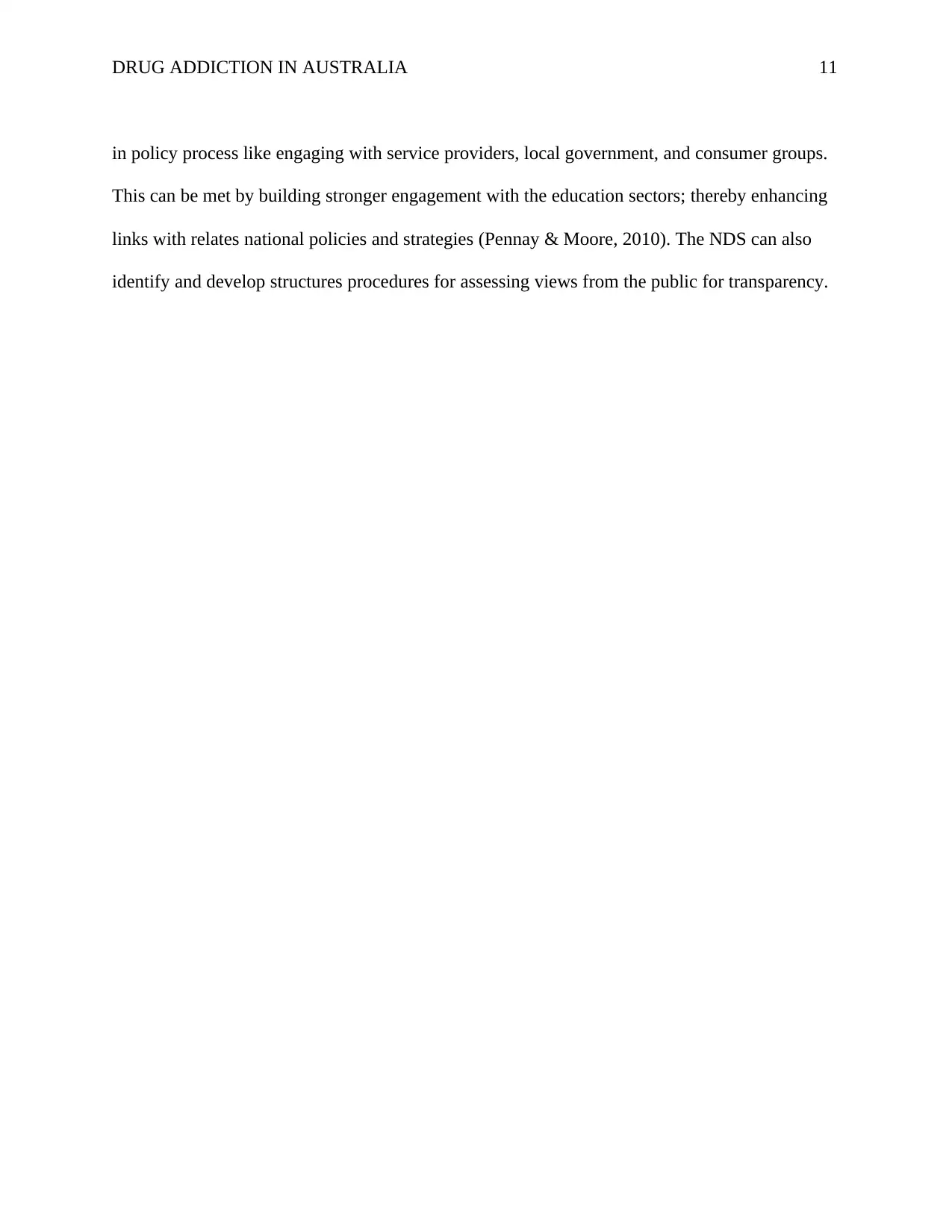
DRUG ADDICTION IN AUSTRALIA 11
in policy process like engaging with service providers, local government, and consumer groups.
This can be met by building stronger engagement with the education sectors; thereby enhancing
links with relates national policies and strategies (Pennay & Moore, 2010). The NDS can also
identify and develop structures procedures for assessing views from the public for transparency.
in policy process like engaging with service providers, local government, and consumer groups.
This can be met by building stronger engagement with the education sectors; thereby enhancing
links with relates national policies and strategies (Pennay & Moore, 2010). The NDS can also
identify and develop structures procedures for assessing views from the public for transparency.
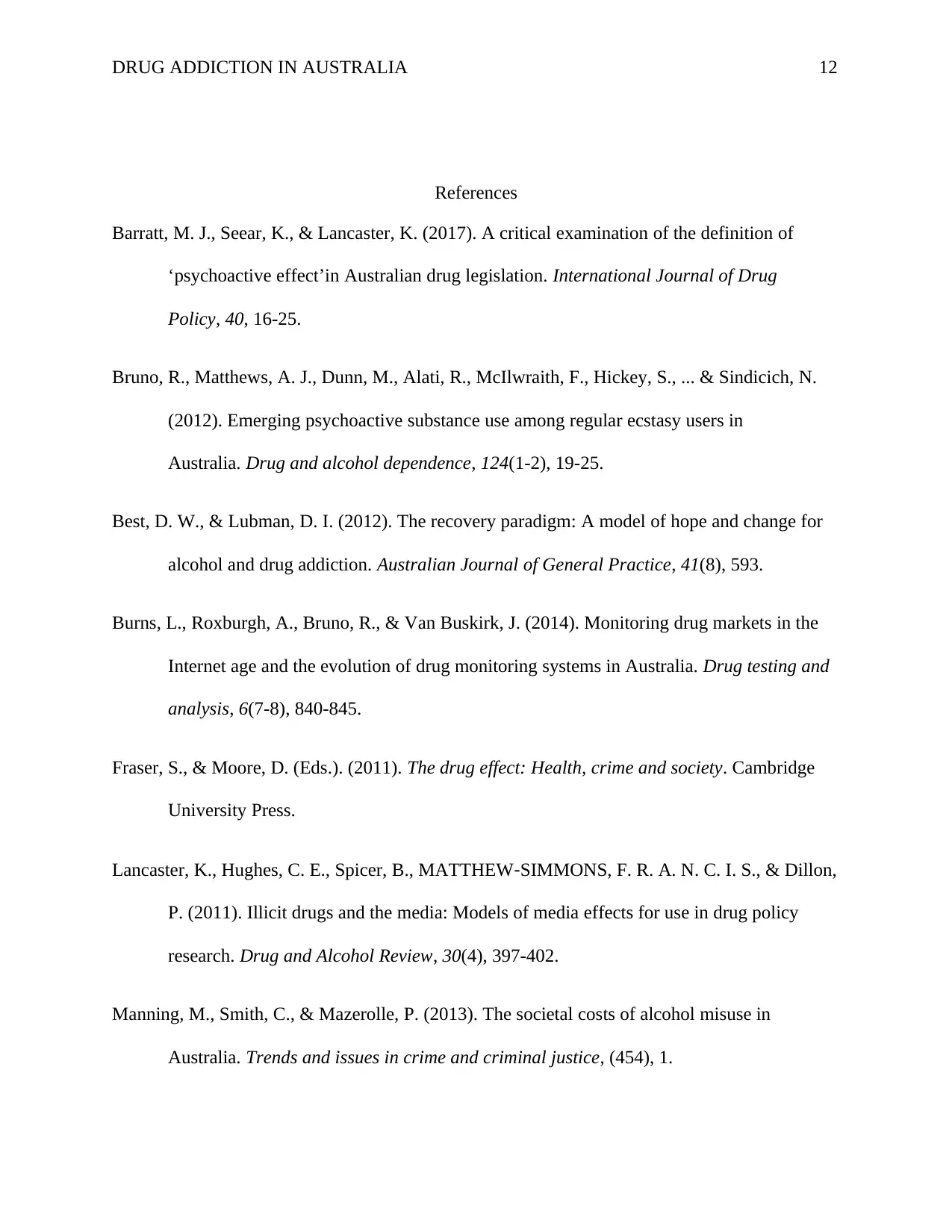
DRUG ADDICTION IN AUSTRALIA 12
References
Barratt, M. J., Seear, K., & Lancaster, K. (2017). A critical examination of the definition of
‘psychoactive effect’in Australian drug legislation. International Journal of Drug
Policy, 40, 16-25.
Bruno, R., Matthews, A. J., Dunn, M., Alati, R., McIlwraith, F., Hickey, S., ... & Sindicich, N.
(2012). Emerging psychoactive substance use among regular ecstasy users in
Australia. Drug and alcohol dependence, 124(1-2), 19-25.
Best, D. W., & Lubman, D. I. (2012). The recovery paradigm: A model of hope and change for
alcohol and drug addiction. Australian Journal of General Practice, 41(8), 593.
Burns, L., Roxburgh, A., Bruno, R., & Van Buskirk, J. (2014). Monitoring drug markets in the
Internet age and the evolution of drug monitoring systems in Australia. Drug testing and
analysis, 6(7-8), 840-845.
Fraser, S., & Moore, D. (Eds.). (2011). The drug effect: Health, crime and society. Cambridge
University Press.
Lancaster, K., Hughes, C. E., Spicer, B., MATTHEW‐SIMMONS, F. R. A. N. C. I. S., & Dillon,
P. (2011). Illicit drugs and the media: Models of media effects for use in drug policy
research. Drug and Alcohol Review, 30(4), 397-402.
Manning, M., Smith, C., & Mazerolle, P. (2013). The societal costs of alcohol misuse in
Australia. Trends and issues in crime and criminal justice, (454), 1.
References
Barratt, M. J., Seear, K., & Lancaster, K. (2017). A critical examination of the definition of
‘psychoactive effect’in Australian drug legislation. International Journal of Drug
Policy, 40, 16-25.
Bruno, R., Matthews, A. J., Dunn, M., Alati, R., McIlwraith, F., Hickey, S., ... & Sindicich, N.
(2012). Emerging psychoactive substance use among regular ecstasy users in
Australia. Drug and alcohol dependence, 124(1-2), 19-25.
Best, D. W., & Lubman, D. I. (2012). The recovery paradigm: A model of hope and change for
alcohol and drug addiction. Australian Journal of General Practice, 41(8), 593.
Burns, L., Roxburgh, A., Bruno, R., & Van Buskirk, J. (2014). Monitoring drug markets in the
Internet age and the evolution of drug monitoring systems in Australia. Drug testing and
analysis, 6(7-8), 840-845.
Fraser, S., & Moore, D. (Eds.). (2011). The drug effect: Health, crime and society. Cambridge
University Press.
Lancaster, K., Hughes, C. E., Spicer, B., MATTHEW‐SIMMONS, F. R. A. N. C. I. S., & Dillon,
P. (2011). Illicit drugs and the media: Models of media effects for use in drug policy
research. Drug and Alcohol Review, 30(4), 397-402.
Manning, M., Smith, C., & Mazerolle, P. (2013). The societal costs of alcohol misuse in
Australia. Trends and issues in crime and criminal justice, (454), 1.
⊘ This is a preview!⊘
Do you want full access?
Subscribe today to unlock all pages.

Trusted by 1+ million students worldwide
1 out of 14
Related Documents
Your All-in-One AI-Powered Toolkit for Academic Success.
+13062052269
info@desklib.com
Available 24*7 on WhatsApp / Email
![[object Object]](/_next/static/media/star-bottom.7253800d.svg)
Unlock your academic potential
Copyright © 2020–2025 A2Z Services. All Rights Reserved. Developed and managed by ZUCOL.





